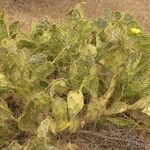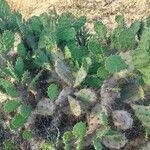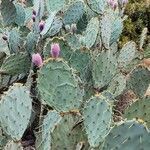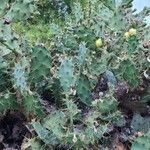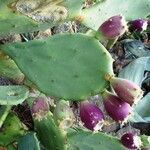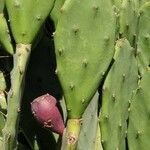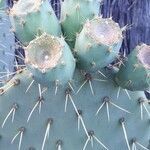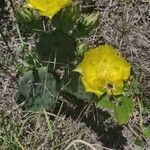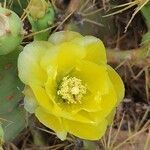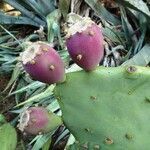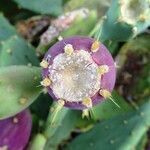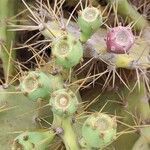Shrubs, sprawling or erect, to 2 m. Stem segments not dis-articulating, green, flattened, narrowly elliptic or obovate, 10-25(-40) × 7.5-15(-25) cm, tuberculate, making margins appear scalloped between raised areoles, glabrous; areoles 3-5 per diagonal row across midstem segment, oval, 3-6.5 × 3.5 mm; wool dense, tan. Spines 0-11 per areole, in nearly all areoles to only in some marginal areoles or absent, spreading in all directions, yellow, aging brown, straight or curving, the longest stout, oval in cross section, 12-40(-60) mm, not markedly barbed. Glochids in-conspicuous, few to many in crescent at adaxial edge of areole, yellow, aging brown, often incurved, subequal to increasing in length toward adaxial edge of areole, to 4 mm. Flowers: inner tepals light yellow throughout, 25-30 mm; filaments yellow; anthers yellow; style and stigma lobes yellowish. Fruits purplish throughout, stipitate, ellipsoid or barrel-shaped, 40-60 × 25-30(-40) mm, juicy, spineless; areoles 6-10. Seeds tan, subcircular, 4-5 × 4-4.5 mm, with slightly irregular surface; girdle protruding to 1 mm. 2n = 44 (cultivated), 66.
Low spreading bushes forming clumps or more upright, up to 2 m tall. Joints flattened, pale green, narrowly elliptic, c. 20 cm long and 10 cm broad; areoles large, 10-12 mm in diam., densely fringed with bristles up to 8 mm long and with white curly wool in the centre; spines up to 20 cm each areole, spreading, varying in length, the longest up to c. 5 cm long, straight or slightly curved, acicular or somewhat flattened, yellow, indistinctly banded when young, becoming brown with age, occasionally absent. Flowers with a slender curved hypanthium, narrowed in lower half; petaloid segments a dirty greenish yellow. Fruit globose, purple, c. 5 cm long, narrowed and curved towards the base, with few areoles; seed c. 5 mm in diam., brownish.
Spreading much-branched dwarf bushes 60-80 cm tall, forming thickets. Joints flattened, broadly to narrowly obovate, 8-15 cm long, glaucous-green, with several straight, spreading, acicular, yellow-brown spines up to 4 cm long, emerging from prominent areoles, or spines few, small or absent. Flowers fairly large, c. 7 cm long, yellow, the hypanthium narrowly tubular, narrowed towards the base, straight or slightly bent, with few areoles; stamens and style about half as long as light yellow petaloid segments. Fruit narrowly obovoid, 4-6 cm long, purple, smooth, with very few or without areoles, apex hollow; seeds c. 5 mm diam., yellowish.
Spreading, much-branched, succulent, dwarf shrub, 0.6-2.0 m high, forming thickets. Cladodes flattened, broadly to narrowly obovate, 230 x 100 mm, glaucous-green; areoles prominent with 4-7 straight, spreading, acicular, yellow-brown spines up to 50 mm long. Flowers yellow. Flowering time Nov.-Jan. Fruit red turning purple, succulent berries, narrowly obovoid, 40-60 mm long, flesh purple inside, sour tasting.
A cactus. It grows 1 m tall. The stems are fleshy with leaf-like joints. These have small scarred leaves on their surface. The joints are 8-15 cm long. It is covered with single or double yellow spines. These can be 2.5 cm long. The flowers are yellow and 60-70 mm long. Flowers have several sepals, petals and stamens. (Opuntia inermis is smaller and usually without spines.) The fruit are red and 4-6 cm long.
Dwarf shrub, 0.6-0.8 m high. Joints flattened, obovate, with several yellow-brown spines from areoles, or spines few or absent. Areoles small. Fruit obovoid, smooth, purple. Flowers yellow.
